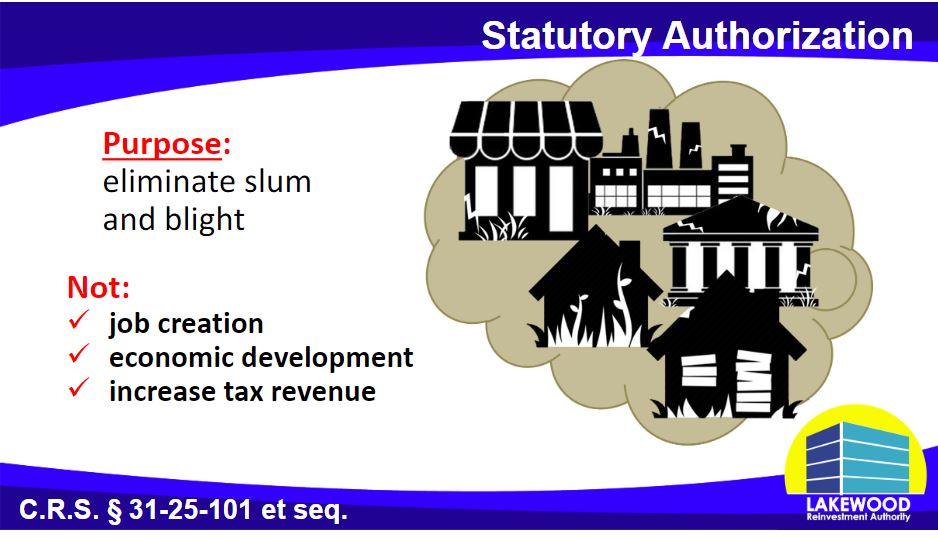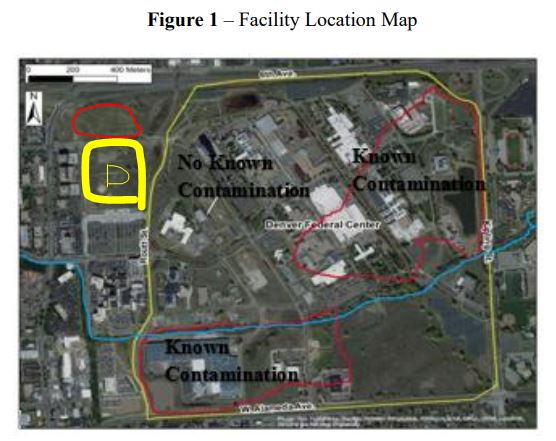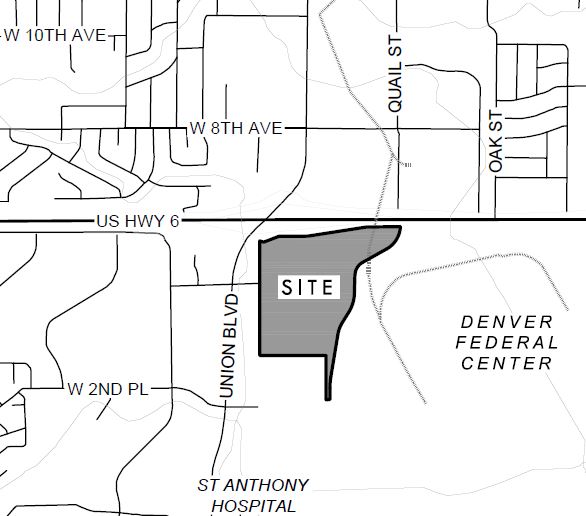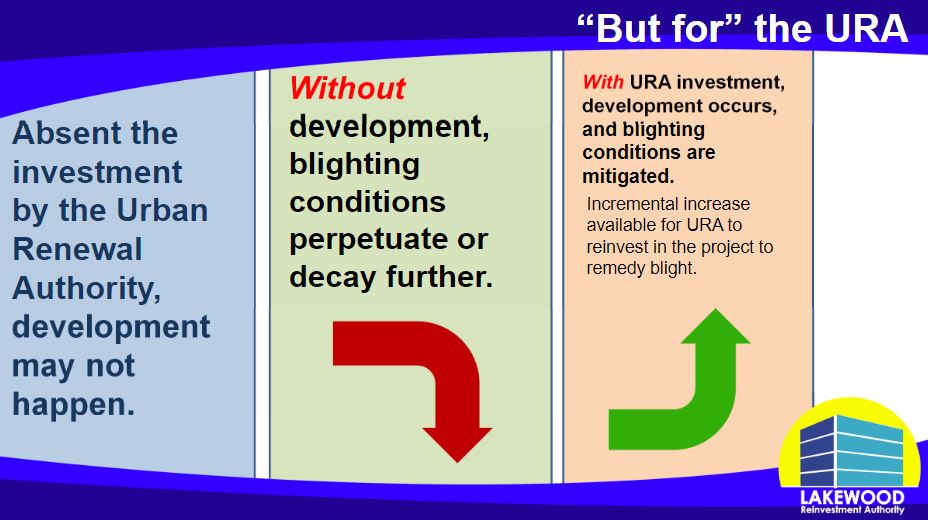Lakewood Playing Games with Blight Statutes to Increase Development
Lakewood is using every tool at its disposal, and then some, to aid development at 4th and Union, known as The Bend. The latest proposal is to blight the property in order to include it in an Urban Renewal Project so that the Lakewood Reinvestment Authority can fund the development. The Lakewood Planning Commission voted unanimously to approve the first step of this process on January 22, 2025. However, despite a presentation on blight, there was no consideration of blight status for this vote and other developments in the area, like St. Anthony’s, did not receive financial assistance. Since the blight finding relies on environmental contamination, Lakewood should get involved in cleaning up a toxic landfill to make this legal, which is also not being proposed. This vote concentrated on whether the new development conforms with the Comprehensive Plan. The Comprehensive Plan was written by Lakewood to include this high-density development, which has been in the works since 2013. There was no examination of whether the residential units being built were needed per the provisions of urban renewal, such as mitigating slums.
Examples of Games
- Eliminate slum and blight – will not, develops around it
- Comprehensive Plan baked in – a new plan is up for approval any time now
- Shortage of safe housing – meant to eliminate slums but city is using for affordable housing
- Playing favorites – Same conditions as St. Anthony’s that didn’t get funding
- But For – Development would happen without city assistance
None of these factors were discussed or by the Planning Commission but one approval leads to another in this process.
No elimination of slum or blight

Per Colorado State Statute 31-25-102 (1), the purpose of a blight designation and urban renewal is to eliminate blight or slums. In a typical blight situation, there has been deterioration of structures that now need repaired. That’s not the case here.
Raw land is not suitable for a blight designation. Adding infrastructure is just development. The problem, as Lakewood seems to see it, is that they want to enable the developer’s goal of 2000 units of high-density residential in an area that wasn’t designed for that many units. A smaller development may work. Lakewood wants to change the standards from when 6th Avenue and Union were constructed to today’s goals of high-density and walkability.
That’s not blight. That’s development. And per Lakewood’s own presentation, it is illegal to use blight designations for the sake of development for its own sake.
The only problem with the land is that there is a toxic landfill on the north end. Neither Lakewood nor the developer is currently proposing mitigating that risk so there is no elimination of blight conditions in this proposal. Merely finding blight, if it even exists, is not enough to comply with statute.
Lakewood points at projects like a landfill in Castle Rock that underwent a similar blight process. During that process, the landfill was cleaned. Cleanup is not proposed for The Bend site which is not a city landfill but a toxic munitions dump. So the underlying blight condition, if any, will remain in place.

Comprehensive Plan Baked in
A new Comprehensive Plan will be approved in February. There was no pause on The Bend blight vote to see if it would meet any revisions that arise during the vote. Both the current and upcoming plan are written in such a way that city staff can interpret Comprehensive Plan goals to mean just about anything. And this area has been targeted by developers (not necessarily residents) for high-density residential for more than 10 years.
In fact, the Comprehensive Plan details what Lakewood would want to see built on that land so this whole argument is circular. It is just the city writing what it wants in multiple places and then using those multiple places as justification.
Shortage of SAFE housing
According toC.R.S. 31-25-107 (5), if residential housing is to be developed, there must be a demonstrated lack of decent, safe and sanitary housing. Remember that this statute is designed to eliminate slums.
“(5) In case the urban renewal area consists of an area of open land which, under the urban renewal plan, is to be developed for residential uses, the governing body shall comply with the applicable provisions of this section and shall also determine that a shortage of housing of sound standards and design which is decent, safe, and sanitary exists in the municipality; that the need for housing accommodations has been or will be increased as a result of the clearance of slums in other areas (including other portions of the urban renewal area); that the conditions of blight in the urban renewal area and the shortage of decent, safe, and sanitary housing cause or contribute to an increase in and spread of disease and crime and constitute a menace to the public health, safety, morals, or welfare; and that the acquisition of the area for residential uses is an integral part of and essential to the program of the municipality.”
Lakewood will not be eliminating slums and there was no consideration of safe and sanitary housing. Instead, Lakewood points to a “shortage” of housing that is in dispute (see “the Totally 100% Fake Housing Shortage”). Lakewood also points to the need for “affordable housing”, which is not considered in statute.
Playing Favorites
St. Anthony’s did not get financial assistance through the Lakewood Reinvestment Authority and it has the same sort of environmental conditions that the land being developed further north has – that is it is technically clean for development. Again, the new development will not be developing or mitigating the toxic landfill that forms the base of the environmental concerns there.
But For
The need for Lakewood to provide this tax incentive is the “But for” argument. “But for” the urban renewal designation, development may not happen. This is patently false since the developers have been planning on funding the project for years without the blight designation.
Tags: blight, federal center, Lakewood, The Bend, urban renewal


Marilyn K Heitmann
I agree that the City of Lakewood is bending the rules to add more houses when the constituents voted to stop unnecessary building like this.
There is no housing crisis, most homeless people are homeless because they want to be. They have drug, mental or emotional issues that housing will nor remedy. Building homes in toxic areas is unconsionable and inhumane, especially if they are intended for low income housing.
They do need to clean up the blighted area for health reasons, and add a green space instead of another crowded and unnecessary housing unit.